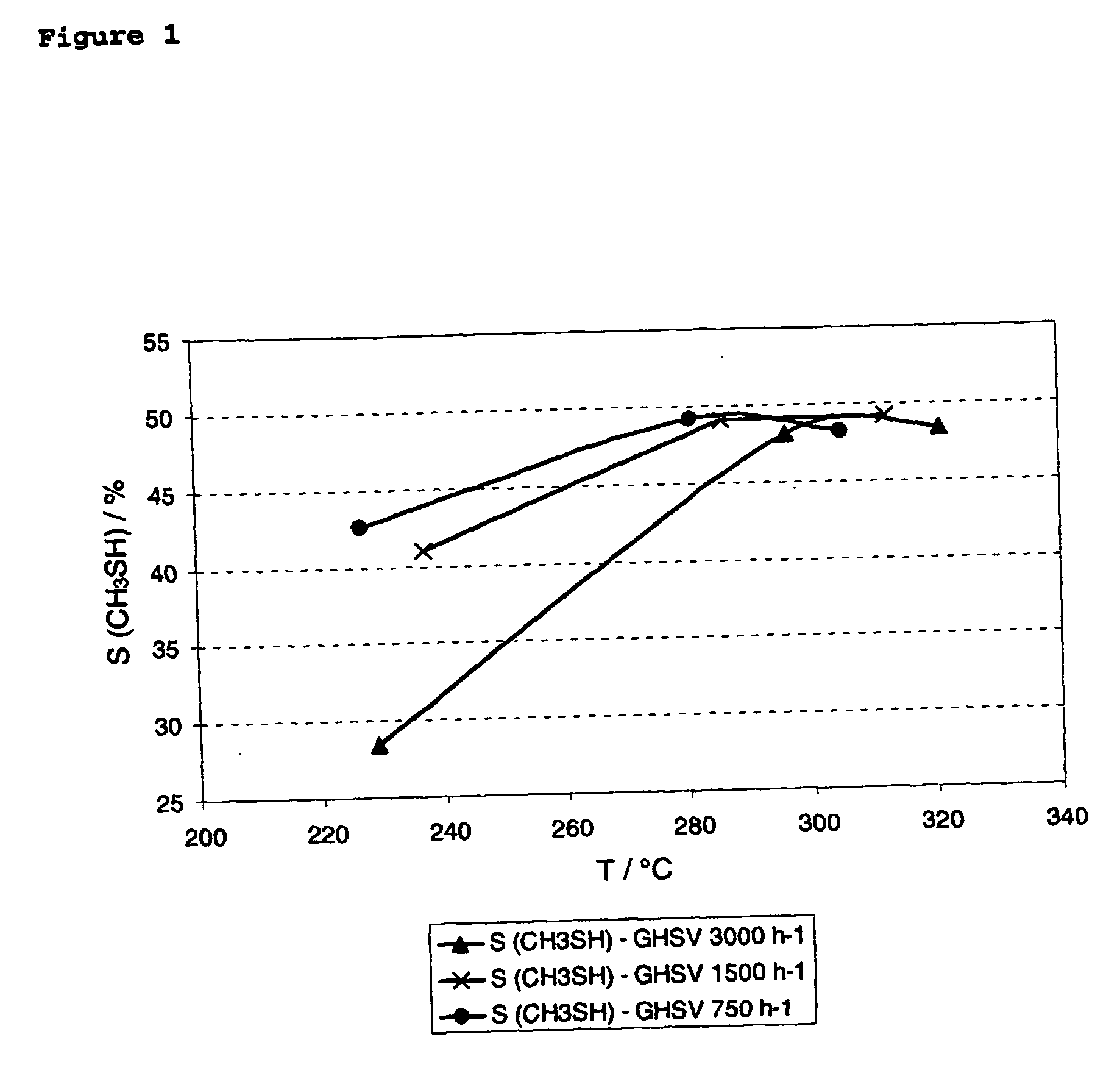Process for the manufacture of methymercaptan
a technology of methylcaptan and methylcaptan, which is applied in the direction of physical/chemical process catalysts, organic compounds/hydrides/coordination complexes catalysts, metal/metal-oxide/metal-hydroxide catalysts, etc. it can solve the problem of low methanethiol space-time yield (0.08 0.19 ghsup>1, >1/sup>cat) and achieve the effect o
- Summary
- Abstract
- Description
- Claims
- Application Information
AI Technical Summary
Benefits of technology
Problems solved by technology
Method used
Image
Examples
example 1
Preparation of the Catalysts A Through E
Catalyst A
[0062] An aqueous solution of 62.0 g of K2MoO4 dissolved in 130 ml of distilled water is prepared, to which 24.9 g of cobalt nitrate and 60 ml of ammonium hydroxide are added successively under continuous agitation. After complete dissolution of the cobalt nitrate, 40 g of citric acid are added under stirring to generate the impregnation liquid. 150 g of SiO2 are brought into contact for 24 h with the impregnation liquid prepared above. Thereafter, the wet catalyst is filtered and dried at room temperature and then dried in an oven at 80° C. for 2 h, followed by calcination at 500° C.
Catalyst B
[0063] 1. An aqueous solution of 8.4 g of ferric nitrate and 13.0 g of nickel nitrate dissolved in 120 ml of distilled water is prepared, to which 10 g of critic acid are then added, under continuous agitation for 30 min to generate the impregnation liquid. Subsequently, 100 g of SiO2 are soaked in the impregnation liquid prepared above ...
example 2
[0070] The catalysts A-E described in Example 1 were tested under the following reaction conditions: the total gas hourly space velocity was 3000 h−1, the reactant molar ratio for CO / H2 / H2S was 1 / 2 / 1, respectively and the catalyst bed temperature was 300° C. (maximum) and the absolute pressure was 7 bar. The catalytic activity was evaluated for a single-pass of the reactor. Determination of conversions and yields were made as described above.
TABLE 1ConversionYield (MC) / Catalyst(CO) / %Yield (MC) / %gMCgcat−1h−1Catalyst A28100.20Catalyst B28110.24Catalyst C29120.25Catalyst D27120.24Catalyst E24100.25
CO = carbon monoxide
MC = methylmercaptan
example 3
[0071] Table 2 shows a comparison of the catalytic activity of a catalyst consisting of Co2O3—K2MoO4 impregnated on a SiO2 carrier as compared to a reference catalyst of pure K2MoO4 supported on the same carrier material. The materials were tested under the following reaction conditions: the total gas hourly space velocity was 3000 h−1, the reactant molar ratio for CO / H2 / H2S was 2 / 7 / 1, respectively, the catalyst bed temperature was 350° C. and the absolute pressure was 10 bar. The catalytic activity was evaluated for a single-pass of the reactor. Determination of conversions and yields were made as described above.
TABLE 2ConversionSelectivityYield (MC) / Catalyst(CO) / %Yield (MC) / %(MC) / %gMCgcat−1h−1Co2O3 / 83380.07K2MoO4 / SiO2K2MoO4 / SiO220.5250.01(referencematerial)
PUM
| Property | Measurement | Unit |
|---|---|---|
| temperatures | aaaaa | aaaaa |
| temperatures | aaaaa | aaaaa |
| temperature | aaaaa | aaaaa |
Abstract
Description
Claims
Application Information
 Login to View More
Login to View More - R&D
- Intellectual Property
- Life Sciences
- Materials
- Tech Scout
- Unparalleled Data Quality
- Higher Quality Content
- 60% Fewer Hallucinations
Browse by: Latest US Patents, China's latest patents, Technical Efficacy Thesaurus, Application Domain, Technology Topic, Popular Technical Reports.
© 2025 PatSnap. All rights reserved.Legal|Privacy policy|Modern Slavery Act Transparency Statement|Sitemap|About US| Contact US: help@patsnap.com

